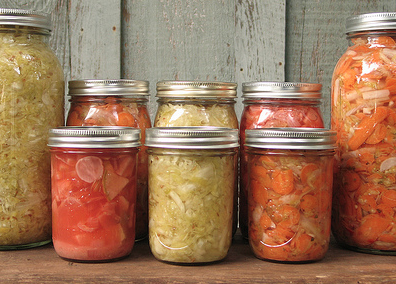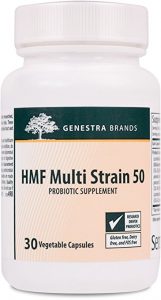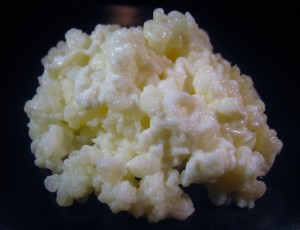A variety of fermented (or cultured) foods are consumed across the globe as a dietary staple. Not only because they’re an excellent way to increase the shelf-life of certain foods, but because they have tremendous health benefits.
- Improving digestion (1, 2, 3, 4) and elimination (1, 2, 3)
- Enhancing immune function (1, 2, 3)
- Increasing nutrition absorption (1)
- Preventing ‘bad’ bacterial overgrowth (1, 2)
- Lowering inflammation (1, 2, 3, 4) and risk of damage (1, 2, 3, 4)
- Improving mood (1, 2, 3) and cognitive function (1)
- Treating gastrointestinal conditions (1, 2, 3)
- Reducing body fat (1, 2, 3, 4, 5, 6, 7)
Unfortunately, it’s a different story in North America. Where personal appliances, grocery stores (on every corner), and preservative packed foods have removed the need for fermentation. While, at the same time, making the gut-supporting, disease-preventing nutrition knowledge disappear.

The reason a positive bacterial balance in our gut is absolutely essential to fighting sickness and disease, is because this is where 80% of our immune system is located.
The ratio of bacteria in our gut to cells in the rest of our body is nearly 10:1.
In a perfect world, 85% or more of this bacteria is ‘good,’ and the hundreds of genes influenced by it are reacting positively to fight disease. In a not so perfect world, we’ve depleted our levels of ‘good’ bacteria, let ‘bad’ bacteria colonize, and compromise the strength of our immune system.
Sadly, most of us are operating in the ‘not so perfect world,’ because of damaging foods (1, 2), damaging drugs (antibiotics, antacids), and a damaging environment. Making the regular consumption of healthy bacteria a necessity more than an option.
The probiotic supplement I recommend in Live It NOT Diet! is a great start, but adding fermented foods to your routine is even more beneficial. Predominantly, because these foods have a higher bacteria count, and more bacterial diversity – helping you increase your level of healthy flora faster, and working towards a level of bacterial variation that was typical of the disease-free hunter-gatherers.
The easiest way to introduce fermented foods, is to start with coleslaw or vegetables that you’re familiar with (carrots, cucumbers, peppers), and then moving on to a more foreign addition like kimchi or sauerkraut (which may not be ‘foreign’ to you). Fermented dairy products (yogurt, kefir, sour cream) can also be great, but not when they’re from a grocery store – as this usually means ‘pasteurized’ dairy, and lots of insulin spiking sugar additives.
But for those with access to raw milk (or grass-fed at the very least), making your own kefir at home is encouraged. Since it provides way more bacteria than you’d ever find in a probiotic supplement (>100 times), and it’s way more affordable. Not only because the kefir grains are cheaper than a probiotic, but because you can reuse them several times before you need to purchase more.
[Note: They’re called kefir grains, but they’re not a grain like wheat, oats, and barley]
Essentially, you purchase a kefir starter granule, and leave it in some raw milk for approximately 12-24 hours. Once it’s transitioned into kefir, you store it in the fridge and consume it as needed – a few tablespoons before bed (like your probiotic supplement) seems to do the trick.
Raw yogurt and milk can also be extremely beneficial. Though to avoid any negative impact on your physique, they’re best consumed in the post-workout period; when whey and insulin is more friend than foe.
Fermented vegetables can be consumed whenever you like (ex: kimchi, sauerkraut, etc), but starting with a small serving at dinner a few times per week is recommended at first. Mainly to get used to the taste, but also because too much at once can be quite potent.
Vegetable Fermentation Directions:
- Choose your vegetable(s) – onions are overpowering; cabbage is a great base
- Peel vegetables with a skin and place in mason jar
- Add herbs and spices (optional) – garlic, ginger, basil, etc
- Mix water or celery juice (preferred) with a starter culture – this is the brine
- (Optional) Add herbs and spices to the brine
- Pour brine into the mason jars to cover the vegetables completely
- Put the lid on loosely and store in a relatively warm (approx. 72 degrees) location
- Check on your mix after 4-7 days, and move to the refrigerator when you’re happy with the flavor

To save money, you can use salt and water instead of a ‘starter culture,’ but the process takes a lot longer and doesn’t provide as much bacterial diversity.
Stay Lean!
Coach Mike
RELATED ARTICLES:
More Antibiotic = Less Probiotic
Beyond Live It NOT Diet! - Test Your Digestion
Don't Mess With the Microbes - Gut Bacteria, Obesity & Disease
Asthma? Eczema? Headaches? IBS? Arthritis? Depression? Go With Your Gut!


